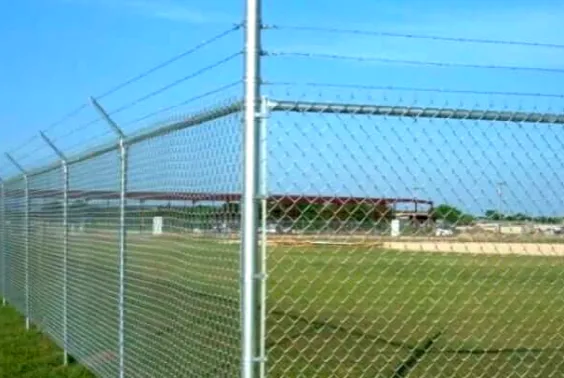Chain Link Fence Installation Tips for a Strong Fence
A strong chain link fence installation needs to be planned carefully before construction because Rome was not built in a day. Every neighborhood has had their share of broken down fences which serve as useless barriers instead of secure boundaries. But it doesn’t have to be that way. The correct methods enable us to build chain link fences that resist time while delivering security and sturdiness for multiple years. The installation process requires careful consideration of post placement along with proper mesh attachment methods. A barrier needs which specific elements to transform from weak to strong and fortress-like? The vital strategies we will discuss will transform the entire process.

Key Points on Chain Link Fence Installation
The chain link fence requires concrete foundations at correct depths with plumb posts for establishing a stable base.
The use of galvanized high-quality materials will provide long-lasting durability through their resistance to rust and corrosion.
A proper tensioning of chain link fabric needs come-along cable pullers to achieve equal tightness.
The mesh requires tight fastening to posts and rails by using tension bands and tie wires which should be installed at regular intervals.
Regular inspections should be conducted to identify damaged parts and loose components which require immediate repair.
Proper Planning and Preparation
Proper Planning and Preparation
The importance of proper planning and preparation becomes clear when we talk about chain link fence installation. These early steps are absolutely essential for achieving project success.
We need to check local building codes and property lines before fence installation because we want to avoid legal problems and confirm compliance with regulations. Our community needs this step for maintaining harmony while we also need it for peace of mind. Using quality materials as described in quality materials helps our fence achieve longevity and durability to handle weather conditions.
We need to define property boundaries, corner locations, and post positions at this stage. The deliberate preparation work we perform now will result in a fence that lasts long while maintaining its strength. A detailed installation sketch will be developed to accurately mark post holes which will serve as our work guide. Our planning must include measurements for setbacks and height regulations because these requirements match neighborhood covenants.
Before we start our project we need to collect both suitable tools and safety gear. The proper tools and safety equipment enable us to measure precisely while establishing a secure installation framework. We install fences to establish boundaries which determine our community space within the neighborhood. Through complete planning and preparation we will establish a smooth chain link fence installation that fulfills all requirements and will last throughout time.
Secure Post Installation
The time has come to focus on post installation safety following our planning stage. The correct installation of chain link fences requires posts to be set properly to achieve long-term stability.
The first step involves digging post holes which should reach 30 inches deep and measure 8 inches wide. Our fence base gets its strength from this foundation. Deep post holes create a rigid fence structure which ensures stability according to deeper post holes.
The installation process includes concrete post setting followed by slope-based concrete preparation to avoid water accumulation. The prevention of premature deterioration depends heavily on this procedure.
The installation of terminal posts includes placing tension bands onto them while facing outwards. The design provides suitable connections for installing chain link fabric later in the installation process.
The addition of post caps serves two purposes: it gives our fence a finished appearance and protects our posts against weather elements.
The brace bands we attach to posts will preserve the structural soundness of our chain link fence. Our post installation work following these steps creates an enduring fence foundation which provides security alongside durability.
Correct Hardware Attachment
We will start by securing our posts before we move on to correctly attaching the hardware. A strong fence structure relies heavily on proper hardware attachment. First, we confirm the correct orientation of rail caps and brace bands. Proper hardware attachment and fence stability requires this step to be done.
The chain link fences, which are made of [galvanized steel](https://texasfence.com/chain-link-security-fences/], need specific installation techniques for them to last long and to be secure.
Next, we will use tension bands to attach the chain link fabric to the posts. It is also important to tighten all nuts and bolts on rails and tension bands to prevent them from loosening over time. The chain link mesh is attached to the rails using galvanized wire or tie wires for a secure attachment.
Let’s follow these important steps to ensure a strong installation:
- Check the orientation of rail caps and brace bands again.
- Attach tension bands to posts and chain link fabric to them.
- Tighten all nuts and bolts on rails and tension bands.
- Use galvanized wire or tie wires to attach mesh to rails.
Tight Fabric Stretching
The next step in chain link fence installation will be to make sure the fabric is tight enough. The fabric tensioning process requires specialized tools like tension bands and come-along cable pullers for proper tension and even fabric stretching.
We will learn how to stretch the fabric evenly and securely fasten it with fence ties at fixed intervals for a long-lasting and professional installation.
Proper Use of Tension Tools
A well-tensioned chain link fence fabric is essential for its durability and visual appeal. This section will cover the correct method of tension tools use to achieve a professional-looking installation that will last for years to come.
To stretch your chain link fabric with uniform tension, we recommend using a come-along cable puller winch. The tool enables us to apply a uniform amount of force across the entire fence line which will prevent sagging or bulging of the fence fabric as time passes. Proper tensioning is essential to preserve the fabric’s strength and durability.
Here’s how to ensure the right tension:
- Attach the come-along cable puller to the fence post and fabric edge
- Gradually tighten the winch, applying even pressure
- Use tension bands and stretcher bars to distribute the force
- Check for uniform tightness along the entire fence line
Stretching Technique Mastery
The stretching technique must be mastered in order to achieve a tight professional-looking chain link fence installation.
A come-along cable puller winch will be used to generate the tension needed for a tight fabric stretch. This tool enables us to put the same amount of pressure throughout the length of chain link fence fabric.
When we pull the fabric tight, we will use tension bands and a tension bar to keep it firm. These components function as a system to share the tension across the top rail and end posts.
We will have to attach the fabric to the terminal posts so that it does not sag with time and the fence stays secure and attractive.
We will take off any excess mesh when we have reached the desired tension. This step is important for a secure attachment and clean appearance.
To preserve the fabric integrity, we will install fence ties every 24 inches on the top rail and line posts. This spacing provides best support and prevents the fabric from loosening.
Uniform Tightness Maintenance
Following our stretching technique mastery, consistent tightness maintenance is the second important step to achieve an expert chain link fence installation. We will concentrate on fabric stretching to get a uniform tightness all over the fence for enhanced durability and security.
Sagging prevention as well as best strength requires consistent tension. These practices will help us preserve the structural integrity of our fence:
- Regular checks: Inspect the fabric and tension bands frequently
- Adjust as needed: Tighten loose areas to maintain even tightness
- Periodic tightening: Schedule routine maintenance to address gradual loosening
- Monitor weak spots: Pay extra attention to areas prone to gaps or sagging
By implementing these steps, we’re ensuring our fence remains taut and effective. Remember, tight fabric prevents gaps that could compromise security. Over time, environmental factors may cause slight loosening, so periodic tightening is essential to maintain the fence’s structural integrity.
We’re not just installing a fence; we’re creating a lasting barrier that stands the test of time. Our dedication to regular tightness maintenance ensures that our chain link fence installation will last long and function properly.
Thorough Rail and Mesh Fastening
Let’s focus on securing our rail connections and mastering proper mesh attachment techniques.
We’ll begin our installation by placing tension bands and brace bands across the top rail and line posts to secure the chain link mesh properly.
The next step involves inserting tension bars through the mesh to secure them to the posts with galvanized wire or tie wires at 24-inch intervals.
Secure Rail Connections
A chain link fence will maintain both stability and longevity only when its rail connections are properly aligned and fastened. We need to verify rail and tension bands alignment before completing the chain link fence fabric attachment during fence installation. To enhance stability, we need to connect the top rail with line posts through brace bands.
To achieve a durable chain link fence we need to follow these essential procedures:
- Pass tension bars through chain link mesh and tension bands to achieve proper mesh tension.
- Fasten the chain link mesh to the top rails using galvanized wire every 12 inches.
- Use tie wires as an alternative to galvanized wire for securing the mesh.
- Regularly check the tautness of the mesh and make adjustments as necessary.
Proper Mesh Attachment Techniques
Chain link fence installation requires correct mesh attachment to rails for proper function. The instructions will show you the correct methods to make sure your chain link fence becomes both strong and secure.
The process begins with mesh weaving through tension bars. The tension bars get secured through tension bands to form a strong bond.
We will secure the chain link mesh to the rails using either galvanized wire or tie wires as the fastening materials. The alignment between rails should be precise since it affects the strength of the entire fence.
We will check mesh tightness during mesh attachment by examining the openings.
We will perform any necessary trimming to create a clean finish if required.
The correct installation of tension bands and brace bands to the rails must be performed.
Regular Maintenance and Checks
Regular inspections combined with proper care ensure that your chain link fence will maintain its effectiveness and longevity. Periodic thorough inspections should be performed to confirm the fence stays in excellent condition. We need to examine specific sections of the fence which tend to get damaged during inspections.
We need to perform the following maintenance tasks:
- Inspect the entire fence structure to check for any tension band or tie damage.
- Check both the chain link fabric and posts for any signs of rust or corrosion.
- The gates need to be properly latched and the hinges need to be correctly positioned for smooth operation.
- The vegetation that grows near the fence requires trimming because it could cause damage.
We need to maintain our fence cleanliness by clearing away debris and dirt buildup because this process leads to long-term damage. Our chain link fence maintenance work provides protection for our investment while maintaining both security and property appearance. A well-maintained fence showcases our dedication toward our community and our property values. Together we can preserve our fences for multiple years of functionality.
Frequently Asked Questions about Chain Link Fence Installation
What steps can I take to increase the strength of my chain link fence?
A chain link fence becomes stronger through the use of heavy gauge wire combined with bottom tension wire installation and privacy slat addition and proper post anchoring and scheduled maintenance. Our community will benefit from collaborative efforts to create an enduring fence structure.
What steps can I take to improve the security features of my chain link fence installation?
We can boost our chain link fence security through the addition of barbed wire or razor wire at the top and the installation of privacy slats and thicker wire gauge and deeper post installation. The installation of security cameras together with motion-activated lighting will provide additional protection.
Every terminal post on a chain link fence needs cementing as a standard practice.
Did you know 80% of fence failures occur at the posts? We’ll cement every terminal post for stability. We typically cement both line posts and terminal posts to ensure our fence remains durable over time. Together we will construct a long-lasting fence barrier.
Chain link fence posts should reach what depth for proper installation?
The recommended depth for installing chain link fence installation of posts reaches 30 inches below ground level. We extend our post installation depths according to the conditions of the soil together with the fence height requirements and local regulations. Our posts will receive complete protection for an extended period through our secure installation.
Takeaway
We have examined the intelligent process for building strong chain link fences. Our discussion has shown the significance of correct planning alongside accurate post positioning to establish an effective boundary. The successful implementation of rigorous rail attachment and meticulous mesh mounting requires significant attention. The process of fabric fastening requires thorough attention with the use of strong tension tools. We will maintain fence strength through a system of scheduled inspections and maintenance tasks. The proper execution of these methods will lead to an effective anti-intrusion apparatus.








